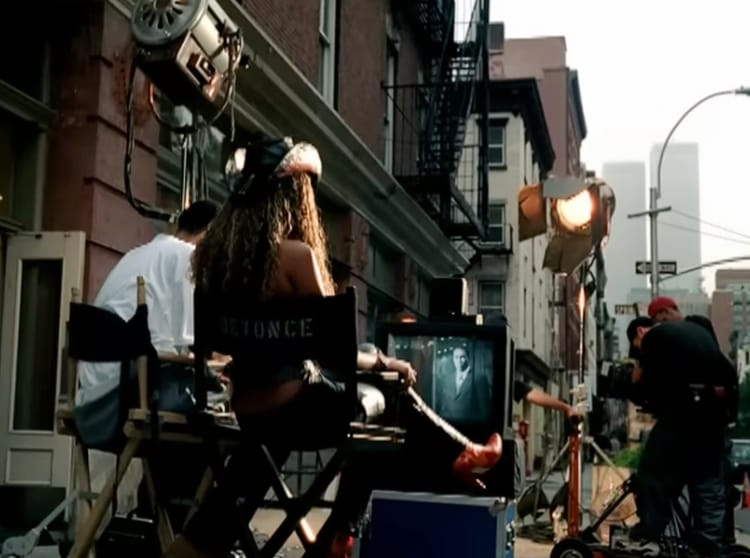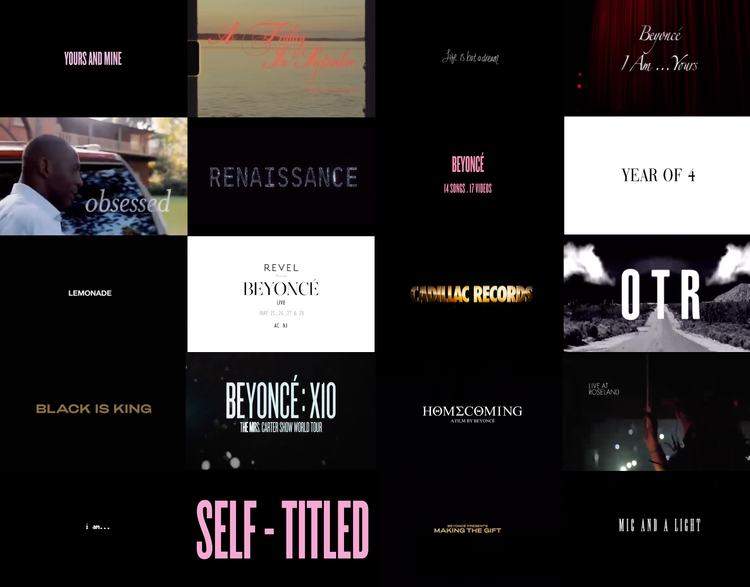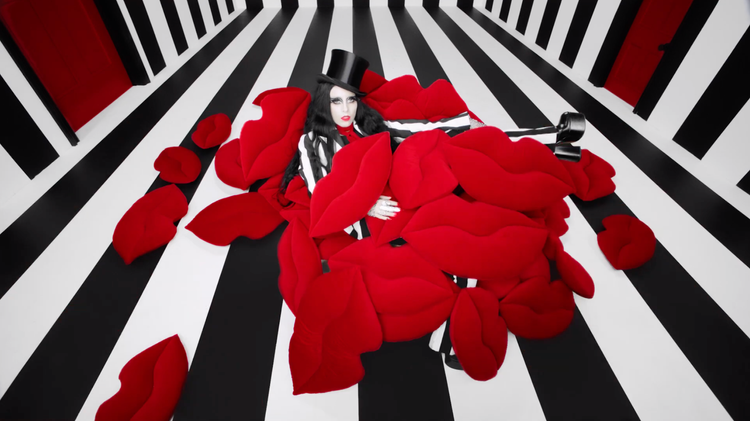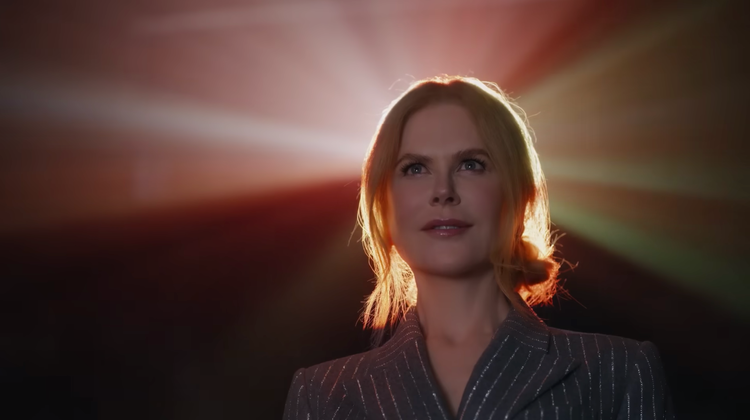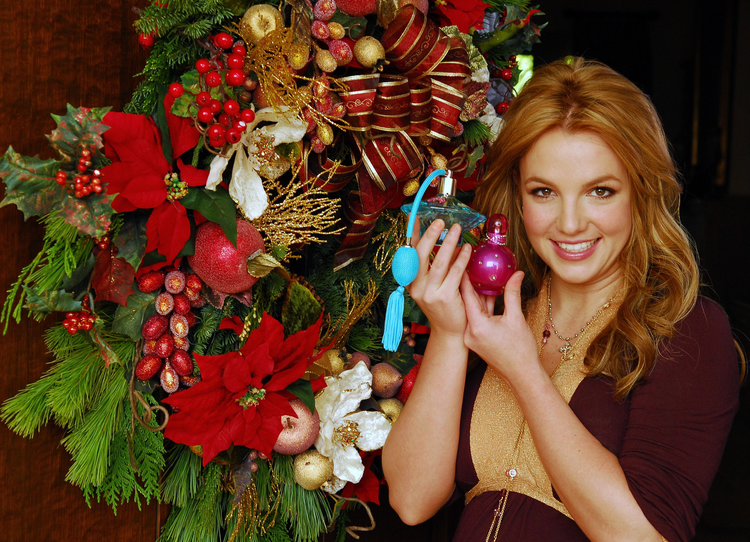Justifying Love
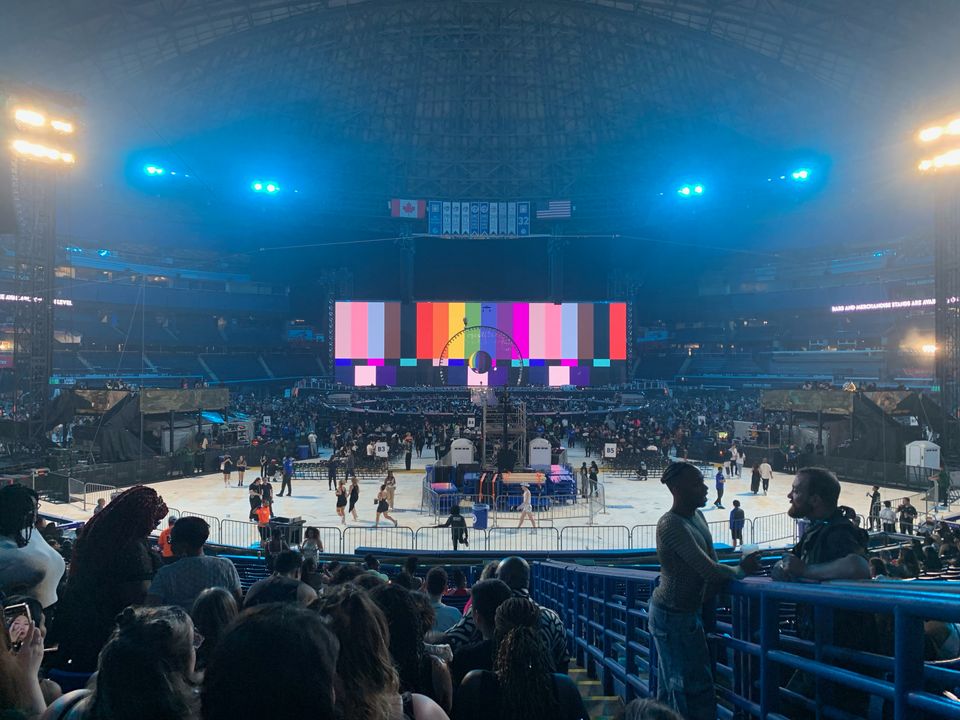
A little while ago, I was lucky enough to get to see my fifth Beyoncé show (and my husband’s third, since he’s also apparently very lucky).
My first was the Toronto stop of the Mrs. Carter Show World Tour that hit prior to the release of her self-titled album. That was July 21, 2013—just over a decade ago. I was standing and decently close to the front, so I have several low-quality Blackberry photos of Beyoncé in that amazing blue-sequined jumpsuit from maybe two metres away. I also did something I didn’t realize was so smart and picked up a tour book; she goes pretty ham on them in terms of both content and actual physical quality (you should see some of the ones I have from other people’s shows that are practically falling apart), and it’s fun and rewarding to watch the stack grow as the years go by.
I’ve in some ways spent the past decade trialling and erroring my way into mastering the art of seeing Beyoncé live. I loved the On the Run Tour in 2014 (floor seat, another book secured), but was admittedly underprepared for the Jay-Z-only bits—a problem I was sure to rectify by his 4:44 Tour in 2017, and a mistake I’d generally never make again (sort of like that time I wore jeans to a Dita Von Teese show). My 2014 self was saved either way by Jonas Åkerlund’s concert film of the OTR Tour, which I can (and do) come back to all the time.
At the Formation World Tour in 2016, I was technically close but far off to one side in a way that was entirely my own doing. The night was fine, but I couldn’t see the screen or dance formations all that well, a shame for Beyoncé’s coolest stage production ever and what was then easily her most iconic tour. There’s always the concert film, I remember thinking—tragically, as there famously would not be one, nor a book for me to peruse in its absence.
By the time of OTR II in 2018, at which point I now also had the whole chronic illness thing to navigate, I’d learned that I most like to have an actual seat (ideally on the aisle), be as centred in the room as possible so that I can later watch the tour in my mind if need be, and of course walk away with a book. I remember not feeling great that evening, and there was again no concert film, but neither thing would really matter: I’d done my homework, I experienced the show as I was surely meant to, and I got my book. If I stepped away for a few minutes somewhere in there, and I don’t remember if I did, the point is that I don’t remember if I did.
I saw the second Toronto show of the Renaissance World Tour on July 9, a Sunday. We’d had a party here on the Friday that doubled as a sort of Beyoncé pregame; a decent chunk of the room would be going on Saturday, and a different chunk on Sunday. As the odd song from the album played out of our speakers, people discussed strategies for arrival time (both audiences would wait almost two hours after doors opened) and wondered what she’d look like (straight hair on Saturday, wavy on Sunday, with some costume differences between the two nights). I again unfortunately didn’t feel great that weekend, but the plan—as it had been in 2018—was to take three different over-the-counter meds, do a dinner date while they kicked in, and then simply sit down in our perfect-to-me seats: on the aisle, as centred in the room as possible. The only thing to really stress about was a book.
I gave myself a just-okay manicure that I’d somehow destroyed by dinner. Scott had picked between two of my bigger sleep shirts (8 Days of Christmas or Mrs. Carter Show; he went for the latter). And then I have the sort of relationship to accessories where I already owned silver cowboy boots and a disco ball-esque purse. To pull everything together, there was never any question that I’d be wearing my Renaissance ringer tee—official merch from last summer where Beyoncé appears to nod to the album cover of Madonna’s Erotica. I was thinking of it as something of a prayer outfit for Madonna, whose team had at that point gone silent as to her post-ICU condition. “I’m also supposed to see her for the first time in August,” I told a couple people at the party, “but I’m not sure what’s happening anymore.”
The whole Madonna episode had me feeling weirdly numb, if I’m being honest. My brain and heart had reacted badly to Tina Turner’s death back in May; it felt at first like the floor had disappeared, but then I couldn’t seem to loose the cry that I could very clearly feel lying in wait for some inconvenient moment to come. I spent last year going through Tina’s solo discography out of mostly reverence, but my interest in her had taken a hard professional turn in the beginning of 2023. There was the interview I published back in April for which I’d combed through her ‘80s video albums, and she also pops up here and there in this massive project I’ve taken on that you’ll (hopefully) hear about later in the year. She was one of those public figures who, to me, seemed kind of unkillable, and not just because she was a giant in our midst. I realize that she’d been different kinds of unwell for the last decade, but… she’d survived both the stroke and the colon cancer, to say nothing of all the other things she’d already survived prior to that in her lifetime. I was truly not expecting to lose her at 83, and it didn’t feel great to still be smack in the middle of my Tina journey at the time of her death, not having gotten to really experience and sit with the full picture yet.
Tony Bennett, who was 96 at the time of his death last week, also felt like one of those unkillable celebrities. A thread in his life story—and in the version of it I told last year—is him having walked away unscathed from an almost comical laundry list of attempts on his life: car accidents, active battle, earthquakes, terrorism, medical emergencies, and even a near-fatal drug overdose. Alzheimer’s felt sort of like just another thing to add to the list, and he’d been living with that for almost a decade—supposedly relatively normally until around the start of the pandemic. Maybe a couple weeks ago, weirdly, I put the I Left My Heart in San Francisco album on for a bath, and thought about how it had now been two whole years since I was invited to write that pre-obit for him, the opportunity I turned down to move ahead with my own piece. Everyone had actively started preparing for this man’s death when he was 94—not excluding me, I suppose—and here he was, days away from 97.
Even weirder, though, and I hesitate to even share this here: I told Scott last Thursday night that I had a feeling it was around the corner, apparently doing my best Tony Shalhoub in Life or Something Like It. I rolled out of bed on Friday morning and immediately got a wave of “I’m sorry” texts from people—almost like I’d lost a relative, which admittedly did make me chuckle a little. To tell the truth, I didn’t really feel anything but peace getting that news, if a sad kind of peace, since I’d done probably everything I could to prepare for it. I’d sat with the full picture; the life story had been learned with awe, the work itself had been engaged with, and—most importantly, I think—the flowers had been given. And the whole experience has been very clarifying for me in terms of how I personally would prefer to exist in the same timeline as living legends.
After the Madonna news, friends of mine started tweeting their distress and sometimes their tears, but I couldn’t seem to produce any of my own. I was still stuck on Tina, with multiple Word docs-in-progress to try and get me unstuck, and I imagine my brain was trying to protect itself in the event of any further bad news.
And though I refused to let myself linger on what that might look like, I think I was quietly comforted by the fact that I felt, well, in the clear or something as far as Madonna went. Whenever that does happen—and I won’t even write it out—it’ll totally suck, full stop. But I can also say with confidence that any chaos in my mind won’t come back to me feeling like I botched it, like I missed my chance to toss an icon any deserved flowers while she was around. Beyoncé and I will have that in common, it seems.
The rough plan had been to see these two spiritually linked tours, the RWT and Madonna’s Celebration Tour, by my two spiritually linked faves just weeks apart (with Madonna turning 65 a few days after my show), and then finally write the piece I’ve forever wanted to write about said spiritual linkage—how the two women have spent the last decade actively in conversation with each other, how I think they play different but comparable roles culturally, how Renaissance introduced a new dynamic to their artistic kinship in the form of Uncle Jonny. I didn’t know anymore whether my plan was still on, but I wanted to wear my t-shirt either way; after all, I knew Beyoncé would be performing the “Queens Remix” of “Break My Soul,” the one that samples “Vogue.” I downed two Cuba libres while my meds kicked in—just as it says to do on their boxes—and then we made our way to the Rogers Centre to join the horde of sequins and mesh and mirror-balled cowboy hats. We got the tour book out of the way first, if only so that I’d shut up about it—and I’ll do the same now in this newsletter, I promise—and stowed it safely in its plastic wrap under my seat, where I could easily tap it with my foot every few minutes to make sure it was still there.
Beyoncé is her own opener for the RWT, performing a number of ballads before the show proper. Certain detractors have called them “random” but there’s nothing really random about them. One is “Dangerously in Love,” the title track from her debut solo album that turned 20 earlier in 2023. Another is “Flaws and All” from B’Day, which comes off as a thank-you to fans—again, because they’ve stood by her as a solo artist for two decades now. Everything in the segment seemed to dovetail with the idea of Beyoncé’s solo career being both commemorated and rebirthed with this highly self-referential 2022 album and its career-spanning 2023 tour. The two ballads she performed from 4—“1+1” and “I Care”—are top-tier love songs, plain and simple; they also refer back to a period defined by a messy but bold personal and professional reset, one that had to be experienced in order to get to something like Renaissance.
And then there’s “River Deep, Mountain High,” the euphoric rock classic originally by Tina Turner (and her demon first husband) that Beyoncé has reworked into a slower, somewhat haunting ballad for the tour—a gospel take fit to tribute a woman raised on church music as well as turn the room into a celebration of her life for those few minutes. Turner died a couple weeks into the tour, so the song has been very gracefully wiggled into the set list, where I imagine it will stay. (Few performers have had such an impact on Beyoncé.)
I’d listened to the original “River Deep, Mountain High” (plus “Private Dancer,” with its breathtaking first octave change) many, many times in the weeks leading up to the show, especially on runs. I love those songs in general, but I think I was also trying to unlock my stubborn cry—and if it finally came out on a treadmill, so be it. And though I knew to expect Beyoncé’s version from social media and was prepared to be at least a little moved by it, I obviously underestimated just how much. In the end, it was what finally unleashed the beast: having recently lost a living legend, not being sure whether I was about to lose another, and feeling truly grateful to be standing in a room with a third, I untucked the hair from behind my ears and basically let myself weep for a bit. I’m not usually one to do anything of the sort in public, but it felt amazing.
It was also, I suppose, my personal contribution to the room’s celebration of reflecting and resetting. A lot has happened in the world since the last time Beyoncé toured, and even more since the last time she toured on her own. It felt like everyone in the room was celebrating being on the other side of something, where I’m sure something looked different from person to person. Even and especially Beyoncé herself: at risk of this sounding like fan babble, different albums and shows have brought with them very different Beyoncés, and this one is visibly having the most fun she’s ever had onstage. She’s also seemingly a lot more open to colouring outside of whatever lines were laid down in rehearsal—missing a lyric to respond to a surprise in the audience, say. And all of it feels very earned.
During the Toronto show the night before mine, Beyoncé had taken a second to bless Madonna during the “Queens Remix”; at my show, because I’d finally gotten my tears out of the way, I was free to simply dance to it in my t-shirt—my godless equivalent of blessing someone, I guess. Beyoncé and I apparently worked some sort of magic together that weekend: Madonna posted a much-desired first-person statement on her condition the next morning. My August show will now instead be some kind of 2024 show, and that’s totally cool. That it’ll happen at all is a blessing of its own, and the stakes have never felt clearer to me.
Today is the 40th anniversary of Madonna, her debut studio album. It’s a chance to reflect if I’ve ever seen one—but perhaps just as much to reset, too. ●
Mononym Mythology is a music video culture newsletter by me, Sydney Urbanek, where I write about mostly pop stars and their visual antics. I do that for free—and actually pay to use this platform—so if you happened to get something out of this instalment, you’re more than welcome to buy me a coffee. The best way to support my work otherwise is by sharing it. Here’s where you can say hello (if you received this in your inbox, you can also reply directly to it), here’s where you can subscribe, and I’m also on Twitter and Instagram.
